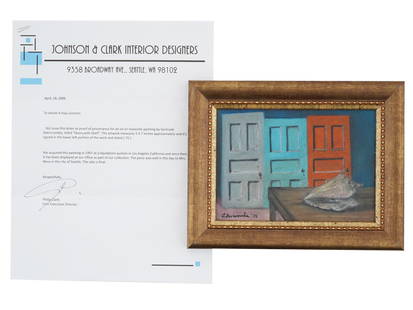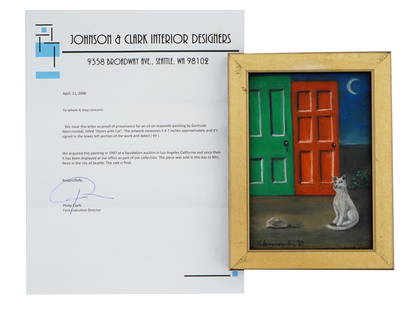
Painting of a Door, Style of Gertrude Abercrombie.
Similar Sale History
View More Items in Paintings
Related Paintings
More Items in Paintings
View MoreRecommended Art
View More






Item Details
Description
It is signed Lower Left, "Abercrombie '54". It is Oil on Masonite, in an Older Frame. The Painting measures 7" x 9 1/2". The Frame measures 10 3/4" x 13". Here is an Evaluation of this Piece by Susan Weininger: February 27, 2023 Authentication for: Gertrude Abercrombie (attributed), Untitled (Stairway and Door), 1954, 7 ¼ x 9 ½”, oil on Masonite, signed and dated lower left Abercrombie ‘54 This painting does not appear in any of my records, nor does it have an established and secure provenance. While that does not preclude it being an authentic work, it requires an analysis of its style and treatment of subject matter in order to determine its authenticity. It is a landscape, perhaps a seascape, with a door in its center and a staircase curving from its beginning in the foreground to a fading out as it reaches the upper part of the door. The turquoise ground seems to be water as it covers the initial steps of the staircase; the sky is brown, darkening as it rises, with a few whitish clouds floating in it. While Abercrombie created many austere landscapes, as well as doors and staircases, there are a number of differences between Abercrombie’s treatment of these elements and what we see in this painting. Abercrombie did many staircases, but to my knowledge they are all created of strict angles rather than curves, aside from one example very early in her career (Still Life with Stairs, 1936, Stern Collection). In this painting there are six curved steps visible through a window; the interior space in the foreground has a typical Abercrombie still life of the period. This staircase is connected to the architectural structure in a naturalistic manner. A single leg appears at the top of the staircase stepping down, creating a sense of mystery typical of the artist. The elements in the painting cohere into a meaningful whole. In the late 1940s Abercrombie did paint a number of examples of isolated staircases in a landscape or other setting, free of any built structure (but none of them curved). These staircases were not placed in a haphazard manner, however. They were embedded in a composition with other elements that enhanced their meaning. Paintings such as Dilemma (2 Doors and Stairs) (1947, location unknown) and Between Two Camps (1948, Illinois State Museum, Springfield) are examples of the use of a freestanding staircase. In paintings such as these and others with different elements of the same period, Abercrombie seems to be dealing with choosing between options, the staircase being one. This was a moment in her life where she was ending her marriage to Bob Livingston and embarking on a new, and different, future with her second husband Frank Sandiford. In the case of Dilemma, she presents the choice as a path to a staircase topped with a door or a truncated path to a door at the base of the staircase, making it clear which option the figure in the painting would take. In Between Two Camps, a small tent sits on one side of the painting opposite the freestanding staircase on which a triumphant Abercrombie stands waving a banner. In each case she chose the staircase, a somewhat risky decision. The point is that the elements in the painting all work together to create meaning in the work. While this is, on one level, a reference to a personal decision in Abercrombie’s life, she transforms it so that it becomes meaningful on a more general level. The painting is about leaving a secure place for something precarious, which has universal relevance. At the same time she sets up this choice in a unique, enigmatic manner characteristic of her approach. Doors, too, had special significance for the artist. From an early period she painted a room which was austere, sealed, impenetrable, and served as a metaphor for her internal feelings of insecurity and isolation whether she was present in the space or not. The room often had a door, sealed and without hinges, incapable of being opened. When urban renewal came to her Hyde Park neighborhood in the later 1950s she became fascinated with the doors that were used as fences around demolished buildings. They were the same kind of doors she had been painting in her rooms for several decades and she began to do paintings of these doors in various combinations, often with a cat or shell or another one of her personal emblems. These, too, functioned as expressions of personal feelings as well as having a more generalized resonance. There are not a lot of examples of isolated doors appearing in a landscape in her work, however. Indecision (ca. 1948, Southern Illinois University Museum, Carbondale) and Snared (1967, Private Collection) are two of the few examples I could identify and in each case the door functions as an integral element of the meaning of the painting. In Indecision, like the previously mentioned examples of the difficult moment between her marriages, the door functions as a symbolic element of choice. The figure of the artist stands between the isolated door, hands raised, and a phallic tower rising in the background—security versus the new, perhaps perilous, love. Snared is a theme Abercrombie explored a number of times and in the example cited she is secured to the door (which is attached to a wall, so not really isolated) by her hair, preventing her from reaching the owl in the tree she faces. The Door and the Rock (1971, formerly Maurer collection, auctioned at Hindman 2022) is one of the last paintings Abercrombie produced and is a beautifully conceived image of an isolated door in a landscape from which a whitish rock/iceberg emerges, again setting up the kind of options that Abercrombie is so fond of. These elements are set in a subtle and seemingly simple composition—the only other element is a white cloud floating above the rock. The arrangement of the door, slightly closer to us than the rock, and the use of the wispy cloud to balance the heaviness of the rock, creates the kind of interesting dynamic compositional interplay that is missing entirely from Untitled. In Untitled the door is centered, the stairs curve around it and there is no tension between the elements. It is quite painterly, the stairs appear almost weightless, and most notable of all is the molding around the door. This would be appropriate if the door were in a room, but to my knowledge Abercrombie never painting a molding around a door unless it was part of an architectural space. This is a bit of evidence that cannot be ignored. And most important, it is hard to derive any meaning consistent with Abercrombie’s oeuvre from this image. Because of the many anomalies of style and subject matter, and the lack of a secure provenance, in my opinion this is not an authentic painting by Gertrude Abercrombie. Susan Weininger Professor Emerita Roosevelt University
Buyer's Premium
- 25%
Painting of a Door, Style of Gertrude Abercrombie.
Estimate $500 - $1,000
32 bidders are watching this item.
Shipping & Pickup Options
Item located in Chicago, IL, usOffers In-House Shipping
Local Pickup Available
Payment
Accepts seamless payments through LiveAuctioneers

Related Searches
TOP









































































![[Custer, Little Big Horn] Eagle Elk, Oglala Sioux Warrior: “I was about 25 the summer we fought Long Hair and I still believed we could drive the white men from our country. I’m a little sad yet about that fight, although it was our finest victory.”](https://p1.liveauctioneers.com/7226/322253/173251540_1_x.jpg?height=310&quality=70&version=1710004847)